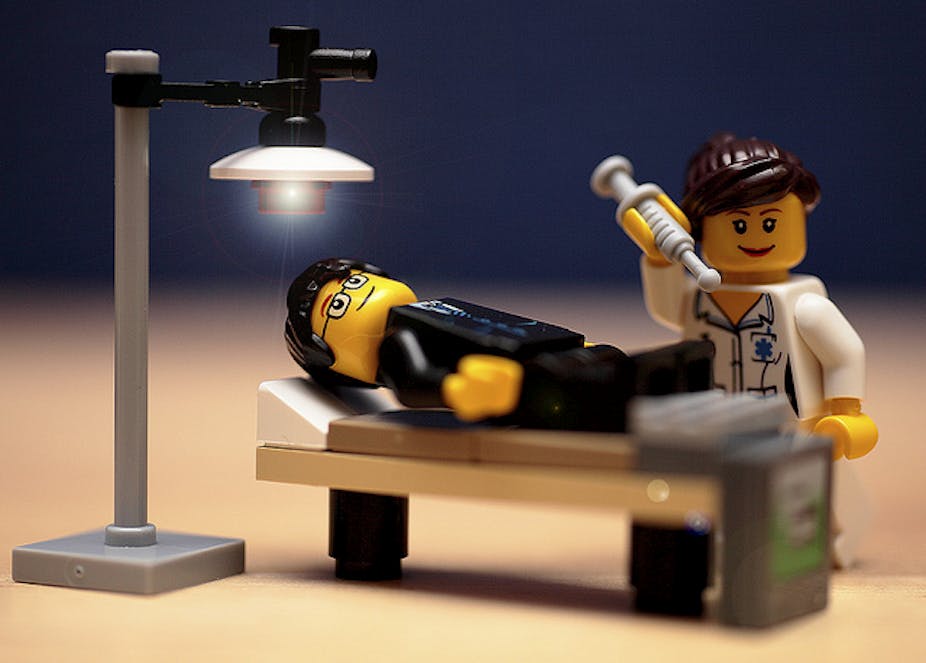The opening of [eight new medical schools](](http://www.medicaldeans.org.au/wp-content/uploads/Website-Stats-2013-Table-4.pdf) in Australia in the past decade has seen a massive increase in the number of new doctors entering the workforce. The number of new junior doctors graduating in Australia doubled between 2004 and 2011. But while fears of an overall shortage of doctors seem assuaged, we don’t have the right mix of doctors.
A recent trend is the increasing specialisation of the medical workforce. In 1999, 45% of Australian doctors were general practitioners (GPs) but this proportion had fallen to 38% by 2009. Similar trends can be observed in the United States and United Kingdom.
This trend is concerning because primary care, provided by general practitioners, is the most efficient and equitable type of health care, particularly preventive care and the management of chronic disease. These components of GP-provided care have the potential to improve health outcomes, lower costs and reduce the need for future more costly interventions.
In contrast, specialists tend to be reactive and expensive, seeing patients only when a health condition has taken a turn for the worse, when surgery, expensive pharmaceuticals, or other intensive treatments are required.
Of course, a modern health-care system needs a high-quality specialist sector; specialists are the doctors patients rely on when they’re sickest. But workforce planners should strike the right balance between primary care and specialist physicians.
So what is causing the growing imbalance towards specialism in medical career decision making?
Our recent study asked junior doctors in Australia about their job preferences. We did this using a discrete-choice experiment, where respondents made hypothetical but realistic choices about their future career. By analysing their responses statistically, we could tell what factors drove their choices.
Our results show a range of factors affect choice of speciality. Opportunity to practice procedural work and academic opportunities are some of the factors that drive junior doctors to specialise rather than choose general practice. But the elephant in the room is money.
Specialists in Australia earn almost twice as much as GPs. Survey data shows average earnings in 2012 of $194,000 for GPs and $360,000 for specialists. Even when adjusted for the longer hours that they work, specialists’ hourly wages are still 60% higher than GPs.
We found expected earnings have a large effect on choice of speciality. But lowering the income gap could redress the situation. Our modelling shows that increasing GPs’ earnings by A$50,000 per year (a 28% increase from 2008 levels) would increase the number of junior doctors choosing general practice by 11%, or 247 more trainee GPs per year.
So, how can policymakers increase GPs earnings relative to specialists?
The main policy tool available is Medicare. Medicare influences GPs’ earnings via rebates for the consultations they provide. Increasing Medicare rebates for GP services would therefore be a simple way of increasing their earnings. Of course, this is entirely the opposite of current government policies to introduce co-payments for bulk-billed consultations and reduce rebates.
Innovative payment mechanisms may provide a more cost-effective way of increasing GPs’ relative earnings. Introducing additional funding sources using capitation (where doctors are paid for looking after enrolled patients for a whole year, not just per consultation) and pay-for-performance would allow earnings increases to be linked to higher quality of care, rather than just the number of consultations provided.
Increased earnings for GPs needn’t blow a hole in the budget either. Offsetting savings could come from targeted reductions to Medicare rebates for specialist services, which would reduce the earning power of specialists, especially those working in private hospitals on privately-insured patients.
In 2012/13, the government spent $3.9bn subsidising private specialist consultations. A proportion of these Medicare subsidies could be redirected to GP consultations.
Together, these measures could reduce the relative earnings advantages of specialists over GPs, encouraging more junior doctors into general practice.

